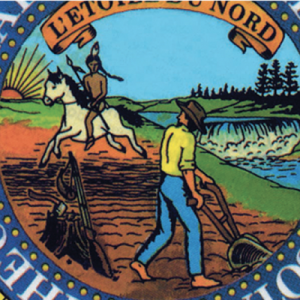Here Congress places its expectation for paying the National debt.
Treaty Commisioner Samuel Holden Parsons
Letter to Mr. Johnson, December 3, 1785
In the American myth, pioneers and settlers are the heroes of the story. They felled trees and moved rocks, in the popular imagination, to transform wilderness into farmland on their own small acreages. They surmounted great challenges - weather, isolation, occasional Indigenous resistance to their presence - to illustrate the merits of hard work and individualism. It was for the benefit of the settlers, according to the American myth, that the US expanded across the continent.
The historical truth, however, is that narrower political and financial interests drove US expansion. Chief among these was the early US mania for land speculation. The Founding Fathers and their immediate heirs personally acquired millions of acres of Indigenous land through treaty making. The settler, more often than not, was their customer. |

Detail: Great Seal of the State of Minnesota |
The Era of Big Speculators
During the American Revolution, the cash-strapped federal government promised millions of acres of land to army officers, as payment for their service. Before the War had even ended, officers were forming the Society of the Cincinnati – America’s first special interest group – to demand that the government make good on its promise. And so land speculation shaped the country's earliest treaty making with Indigenous nations.
In fact, the early federal government could not function financially without acquiring Indigenous land and selling it to the highest bidder. And the buyers of that land, major land speculators, were themselves the men who determined US-Indian policy: leaders of the Revolution, members of Congress and their families, the nation’s elite. At times, they used their positions of power to fraudulently acquire millions of acres.
The transfer of Indigenous land to US control was so important to the fortunes of land speculators that they and their representatives attended the treaties personally, and signed the treaties as commissioners or witnesses. |
Some of the major land speculators among the US Treaty Signers:
The Great American Land Bubble (A. M. Sakolski, 1932) documents land speculation in the early US. To dowload the book, Click Here.
|
|
